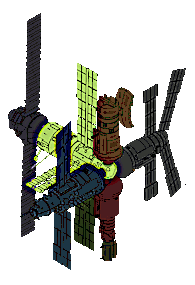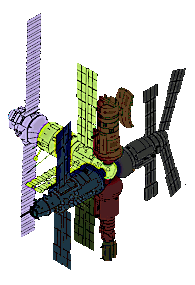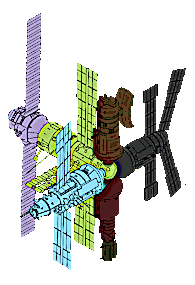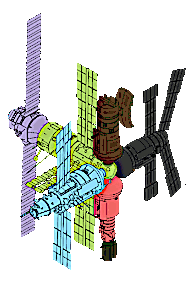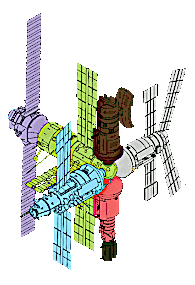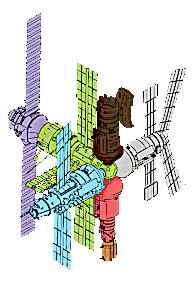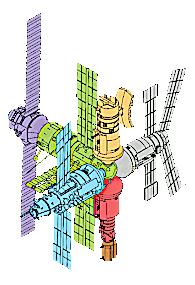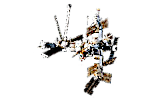
The main components of the Mir Space Station include modules, structures and major equipment items. This article covers the main components which have been assembled in orbit, in sequence, to build the station.
Some of these components were pre-assembled before being transported to the station, although most were transported separately.
This article includes additional pages giving an overview of technical details for the main components. To access these pages, refer to the Main Component Relationships and Description section below.
This page contains two sections showing different aspects of the station's main components:-
Component Relationships and Descriptions ▽Includes a diagram showing the relationship between the components, their position on the station and a brief description of each component.
Main Component Assembly Sequence ▽A series of diagrams showing the sequence of installation of the main components on the station in launch date order.
Mir's main components and their location on the station is shown in the diagram below.
To go to the component's 'Technical Detail Page' click on component heading in the text or diagram.
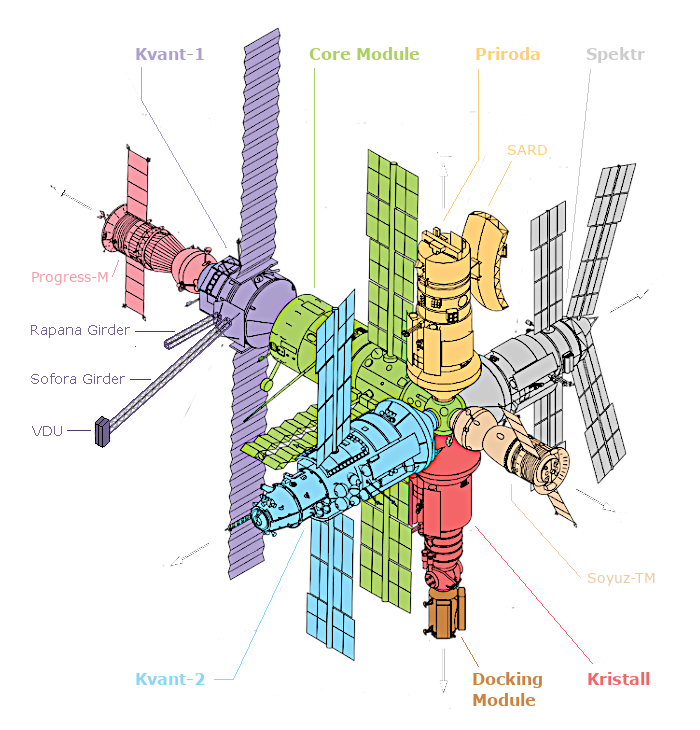
Core Module or DOS-7, was the base block for the entire Mir complex. It provided the main living quarters for resident crews and contained environmental systems, early attitude control systems and the station's main engines.
Strela Cargo Cranes Two were mounted to the sides of the core module and used for moving spacewalking cosmonauts and parts during EVA's. They consisted of telescopic poles assembled in sections 1.8 m collapsed and 14 m long extended. They were deployed using a hand crank and could access all of the station's modules.
Kvant-1 (Astrophysics Module) was the first expansion module. It consisted of two pressurised working compartments and one un-pressurised experiment compartment.
Sofora Girder The largest un-pressurised element consisting of 20 segments which projected 14 metres from its mount on Kvant-1. A thruster block, the VDU, was mounted on the end of Sofora to augment the roll-control thrusters on the core module.
Rapana Girder An un-pressurised element mounted aft of Sofora Girder on Kvant-1. It was a small prototype of a structure intended to be used on Mir-2 to hold large parabolic dishes. It was 5 metres long and used as a mounting point for exposure experiments.
Kvant-2 (Augmentation Module) was the first TKS based module. It was divided into three compartments: an EVA airlock, an instrument/cargo compartment (which could function as a backup airlock), and an instrument/experiment compartment.
Kristall (Technology Module) was the fourth module launched. It consisted of two main sections. The first was largely used for materials processing , astronomical observations, and a biotechnology experiment. The second section was a docking compartment which featured two APAS-89 docking ports used during the Shuttle-Mir programme.
Spektr (Power Module) was the first of the three modules launched during the Shuttle-Mir programme; it served as the living quarters for American astronauts and housed NASA-sponsored experiments. The module was designed for remote observation of Earth's environment and contained atmospheric and surface research equipment.
Docking Module was designed to help simplify Space Shuttle dockings to Mir. With the addition of the docking module, enough clearance was provided for the shuttle without the need to relocate Kristall. It had two identical APAS-89 docking ports.
Priroda (Earth Sensing Module) was the seventh and final Mir module. It's primary purpose was to conduct Earth resource experiments through remote sensing and to develop and verify remote sensing methods. It possessed both pressurised and un-pressurised segments and an externally mounted synthetic aperture radar dish.
Travers Synthetic Aperture Radar Dish (SARD) uses a radar that creates two-dimensional images or three-dimensional reconstructions of objects. It uses the motion of the radar antenna over a target to provide finer spatial resolution than conventional beam-scanning radars.
The assembly of the main components in orbit is shown in the following images.
The hi-lighted components indicate the order in which each component was added to the station.
